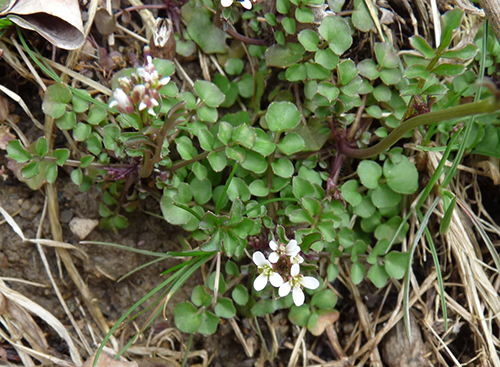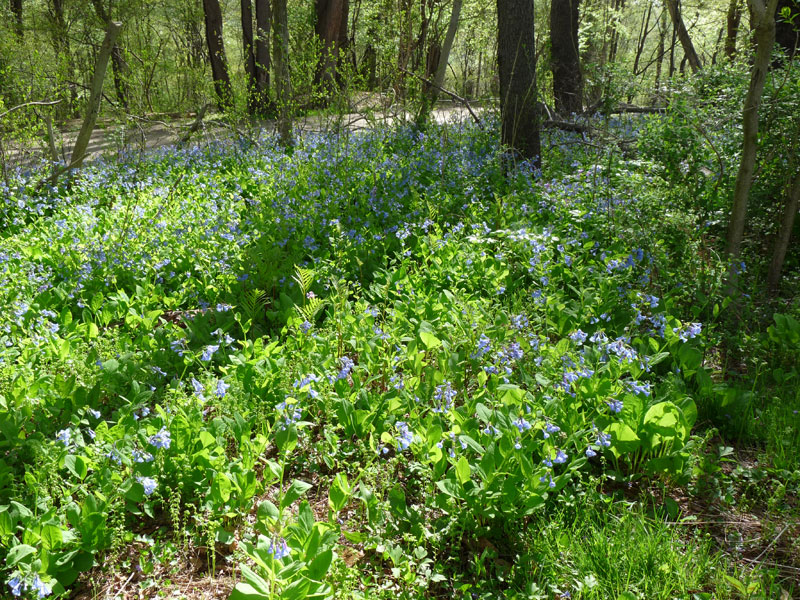 Last Saturday we headed over to Harrison Hills Park to check out the latest wildflower bloomings and to see how our new dog (“Izzy”) would fare on a woodland trail. We parked in between the Spicebush and Pond Loop trails and headed off into the woods. Izzy, by the way, who is a three year old terrier mix, did great!
Last Saturday we headed over to Harrison Hills Park to check out the latest wildflower bloomings and to see how our new dog (“Izzy”) would fare on a woodland trail. We parked in between the Spicebush and Pond Loop trails and headed off into the woods. Izzy, by the way, who is a three year old terrier mix, did great!
On the Spicebush Trail we saw the emerging green and purple-blotched leaves of trout lily (Erythronium americanum). There were no flowers yet, but we will watch this patch over the next week or so. The name “trout lily,” by the way, comes from a very creative observation that these odd patterned leaves look like the sides of a brook trout. I personally can’t see the resemblance, but that is the historical origin of the name!
 All along the trail there was a haze of very small flowers hovering just over a ground cover of dark green leaves. This flower haze was made up of the pink to white flowers of spring beauty (Clatonia virginica) (picture above by D. Sillman) and the equally tiny, white flowers of cutleaf toothwort (Cardamine concatenate) and it’s close relative hairy bittercress (Cardamine hirsute) (picture by D. Sillman).
All along the trail there was a haze of very small flowers hovering just over a ground cover of dark green leaves. This flower haze was made up of the pink to white flowers of spring beauty (Clatonia virginica) (picture above by D. Sillman) and the equally tiny, white flowers of cutleaf toothwort (Cardamine concatenate) and it’s close relative hairy bittercress (Cardamine hirsute) (picture by D. Sillman).
We also saw the larger white flowers of bloodroot (Sanguinaria canadensis) with their distinctive yellow-orange centers. All parts of the bloodroot plant are full of complex alkaloids which renders the plant quite poisonous (deer, for example, graze on the very young leaves of bloodroot but avoid it after the alkaloids have had time to accumulate). These alkaloids, though, represent some potential chemicals that are used in a number of traditional medicine systems. Extracts of bloodroot can remove warts and have been used to treat some skin cancers (although it is noted that these treatments can be quite disfiguring!).
The distinctive three leafed stalks of trillium (both Trillium grandiflorum (the white, large flowering trillium) and Trillium erectum (the red flowered trillium)) are up all along the trail, too, but none of the plants had flowered yet. They will be blooming soon, though, I am sure.
There was little other green in the understory because few plants have developed leaves yet. Some exceptions to this observation are the alien exotic species of multiflora rose, barberry and a set of invasive honeysuckles (including Japanese, Amur, and Tatarian honeysuckle). These Asian invasives get a head start on almost every native shrub or understory plant and very effectively shade out large sections of the forest floor. The extent of their distribution and abundance in our forest ecosystems is most obvious at this time of the early spring. Anything that is green now is most likely one of these very invasive plants.
 We did the mile and a quarter of the Spicebush Trail and then walked down to the Pond Loop. Near the road that runs down to the soccer fields is a patch of Virginia Blue Bells (Mertensia virginica) that is up and covered with clusters of funnel shaped flowers (picture (from 2013) by D. Sillman). The flowers right now are a magenta color, but they will steadily turn bluer and bluer over the coming days.
We did the mile and a quarter of the Spicebush Trail and then walked down to the Pond Loop. Near the road that runs down to the soccer fields is a patch of Virginia Blue Bells (Mertensia virginica) that is up and covered with clusters of funnel shaped flowers (picture (from 2013) by D. Sillman). The flowers right now are a magenta color, but they will steadily turn bluer and bluer over the coming days.
Another blue flower, just a bit further down the Pond Loop trail, is growing in small clusters under a number of low trees and shrubs. Deborah has identified this flower as an exotic species, probably planted in an old garden or in a flower bed around some now long-gone house. It is a native of the White Mountains of Crete and is called “dwarf glory of the snow” in honor of its early spring emergence and blooming. Its scientific name is Chionodoxa nana, and its six petaled flowers are as deep and as intense a blue as you will ever see in nature!
The pond, by the way, was alive with mating toads! Buffo americanus (the America toad) (now called Anaxyrus americanus) filled the edges of the pond with swimming, singing, and mating pairs. The songs of the males filled the space around the pond with complex cascades of interlaced, trillings covering a broad range of volumes and frequencies. We stood very still on the boardwalk and marveled at the exuberance of these toads. There will be many thousands of tadpoles in the pond very soon!
On Sunday we went down to Rock Furnace Trail of the Roaring Run Watershed Association to check out the flowers we had seen a week and half before. Again, we took Izzy with us and were very pleased at her adjustment to “forest life!”
-thumb-300x204-400700.jpg) As we had seen the day before in Harrison Hills, along Rock Furnace spring beauty, cutleaf toothwort, and hairy bitter cress were flowering everywhere! Blood root was also in flower in abundance. The trout lily here, though, was well into flowering. Its beautiful yellow flowers positively glowed in the afternoon sunlight (picture by D. Sillman).
As we had seen the day before in Harrison Hills, along Rock Furnace spring beauty, cutleaf toothwort, and hairy bitter cress were flowering everywhere! Blood root was also in flower in abundance. The trout lily here, though, was well into flowering. Its beautiful yellow flowers positively glowed in the afternoon sunlight (picture by D. Sillman).
Trillium (primarily the large flowering trillium) is also flowering along Rock Furnace! The three, white petals of T. grandiforum is lighting up the brown expanses of dried leaves and fallen branches. There are places along this trail where entire hillsides will be covered with these stunning flowers. They are just getting started, so that incredible experience is just a week or so of warm weather away!
-thumb-300x225-400702.jpg) Dutchman’s breeches (Dicentra cucullaria) is also blooming along Rock Furnace! (picture by D. Sillman). It seems to grow most abundantly on the crumbling slopes on the upside of the trail. We have been unsuccessfully looking for this species at Harrison Hills for the past two years. It is surprising that it is not part of the flora of the park!
Dutchman’s breeches (Dicentra cucullaria) is also blooming along Rock Furnace! (picture by D. Sillman). It seems to grow most abundantly on the crumbling slopes on the upside of the trail. We have been unsuccessfully looking for this species at Harrison Hills for the past two years. It is surprising that it is not part of the flora of the park!
We also saw several individuals of four species of butterflies while we were walking (mourning cloaks, spring azures, cabbage whites, and one whose identity we are still working on!). There was much less multiflora rose along this trail compared to Harrison Hills, much less barberry or honeysuckle, too. As we noted last year, this site gets an earlier start on its leafing and flowering than Harrison Hills. It also seems to have a denser, although not significantly richer, community of herbaceous plants and wildflowers.
More and more birds are coming into my sunflower seed feeders! The volume of seed eaten per day is going up! I even saw a wild turkey hen cruising through my backyard yesterday! Wildlife along with Spring has arrived for all of us to enjoy!
